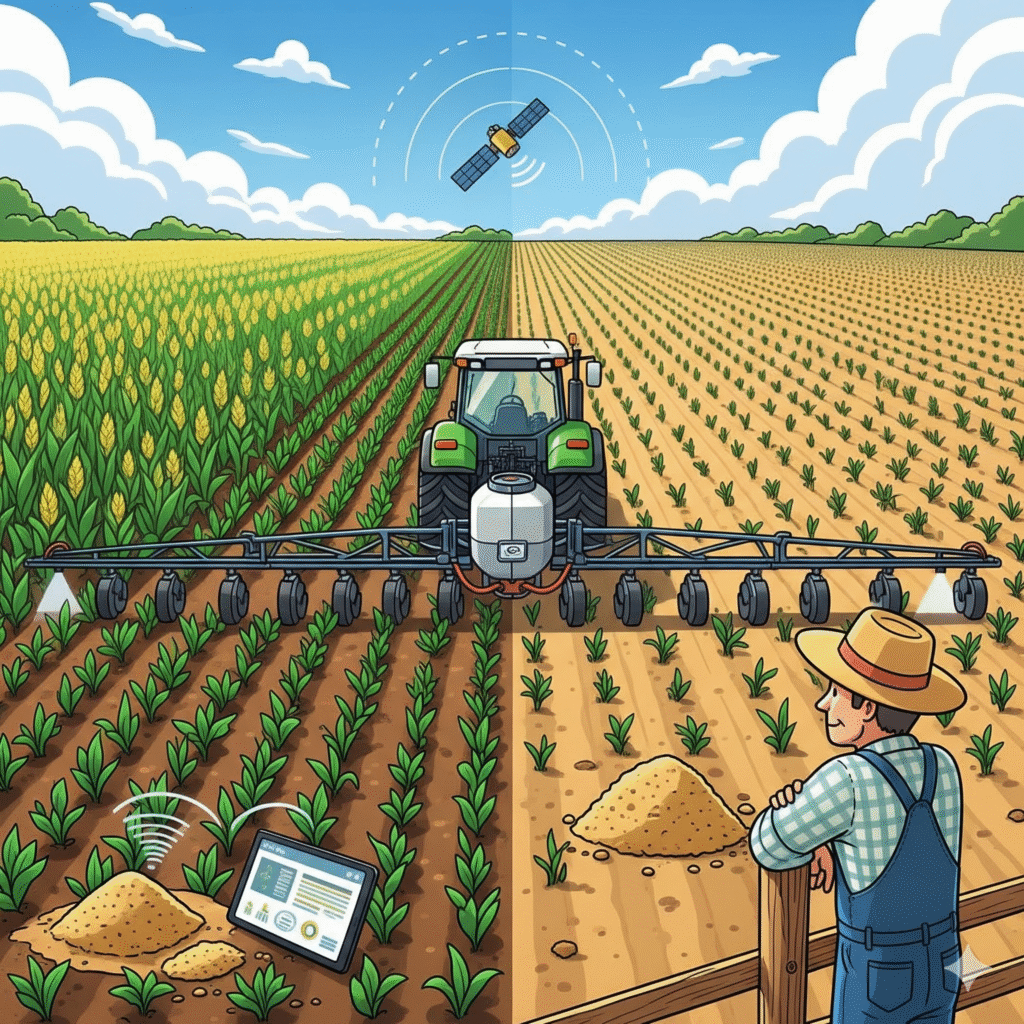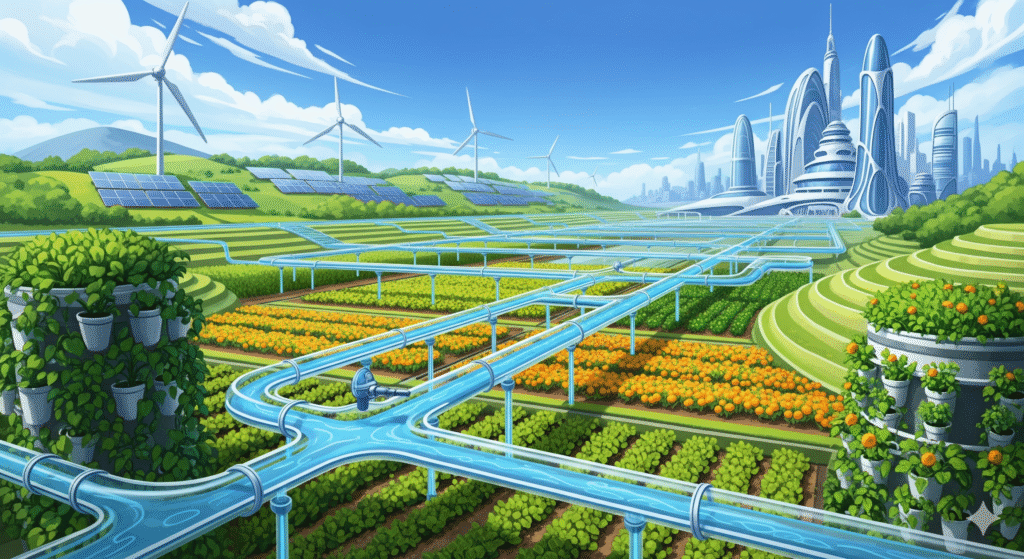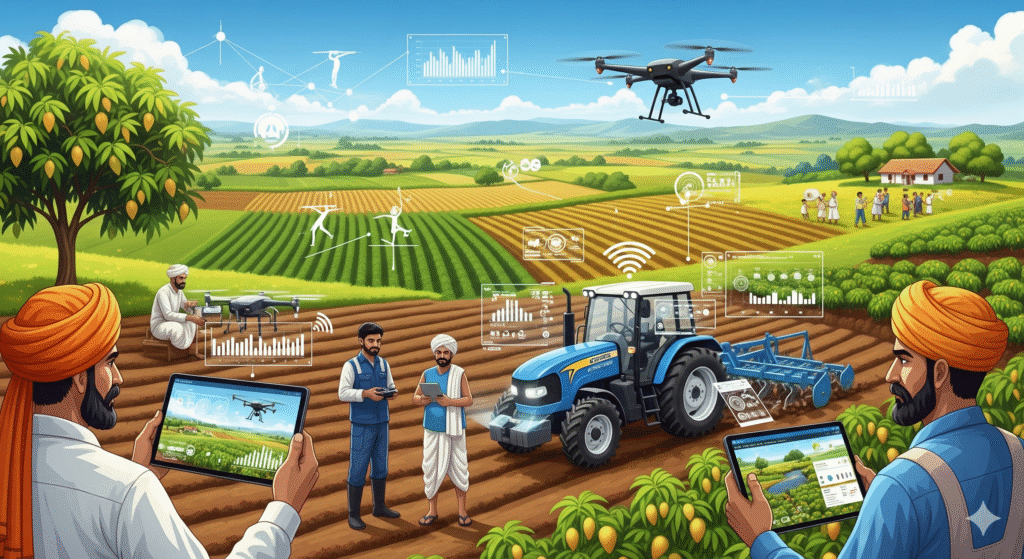Wednesday, 3 December 2025


In an exclusive AgroSpectrum interview, Devjyoti Biswas, Country Manager, FJ Dynamics shared its mission to make precision agriculture accessible for India’s small and mid-sized farmers through affordable, easy-to-use technologies. The company highlighted its autosteering systems, GNSS land leveling, and smart implements, which together help cut fuel and input costs, save water, and boost yields. FJDynamics also emphasized the importance of ISOBUS compatibility and its FieldFusion digital platform, enabling farmers to seamlessly connect mixed equipment and access actionable data for better decision-making. A key focus is on localizing solutions through dealer networks, government subsidy integration, and pilot projects across diverse agro-climatic zones. With scalable, climate-resilient solutions and fast on-ground support, FJDynamics aims to empower Indian farmers to transition smoothly into modern, resource-efficient farming.
How is FJDynamics making precision agriculture more accessible to small and mid-sized Indian farmers?

FJDynamics is on a mission to make precision agriculture accessible to India’s small and mid-sized farmers by offering cost-effective, easy-to-use technologies that are designed to deliver measurable results without requiring heavy investments or extensive technical expertise. Its portfolio of solutions includes autosteering systems, GNSS land leveling, and smart implements — all aimed at improving efficiency, reducing input costs, and boosting yields.
One of the most popular offerings is FJDynamics’ autosteering systems, which bring “hands-free” farming to the field. These systems help farmers cut costs by reducing overlaps and skips, resulting in 10–15 per cent lower diesel consumption, and are available as scalable kits that retrofit quickly to existing tractors and implements such as sprayers, fertilizer spreaders, and seeders. Ease of use is a key focus: an intuitive tablet interface — available in Hindi — guides operators with minimal training.
Farmers can choose between two tablet sizes, 10-inch and 12-inch, depending on their needs. The systems are not dependent on GPS alone but work with India’s NavIC satellites, ensuring reliability even in remote regions. The product range caters to different needs and budgets: the FAG1 is an assisted-driving system offering five modular solutions, including ISOBUS support and upgradable autosteering for those new to precision farming, while the AT2 Lite, AT2, and AT2 Max provide fully automatic autosteering options at multiple price points for farmers ready to move beyond assisted driving.
FJDynamics also brings advanced GNSS land leveling technology to smallholders, helping optimize water and labor use. Its precision grading solutions use GNSS-controlled scrapers with ±2.5 cm accuracy, which can reduce water usage by up to 22 per cent in paddy fields and prevent waterlogging in regions like Punjab and Haryana, thereby maintaining soil health and controlling salinity. The technology is also cost-effective, as it qualifies for government subsidies under the SMAM program, which covers 40–50 per cent of the capital cost for farmers.
The company’s range of smart implements bridges the gap between low-tech attachments and high-tech precision control. ISOBUS-enabled sprayers, for example, can automatically switch sections on and off and control flow rates based on live location data, helping farmers reduce wastage. Angle sensors monitor implement movement and provide real-time navigation alerts to maintain accuracy in field operations.
These implements come with flexible power options, supporting both in-cab and external power supply for up to 24 hours of runtime — ideal for small farms with long operating hours. Data can be shared offline via USB when connectivity is unavailable, and synchronized online when a connection is restored, ensuring farmers can access their operational data seamlessly.
Scalability is another key strength of FJDynamics’ approach, allowing farmers with fragmented holdings to benefit from precision technologies. Devices come pre-loaded with settings for over 40 tractor brands and more than 1,000 models, enabling hyperlocal customization and plug-and-play deployment.
The impact of these solutions on smallholder economics is significant. Autosteering systems can cut initial manpower input by 50 per cent, reduce fuel usage by 10 per cent, and deliver a 3–7 per cent yield increase per unit area. GNSS land leveling reduces water use by 22 per cent and boosts rice yields by 5 per cent. Smart sprayers lower fertilizer and pesticide usage by 10–20 per cent, delivering up to 12 per cent cost savings. ISOBUS-enabled systems can save farmers approximately 1,500 euros (about Rs 1,53,703) every year through optimized input management and reduced wastage.
Together, these innovations make precision agriculture scalable, practical, and profitable for India’s small and mid-sized farms — empowering them to adopt modern practices, conserve resources, and improve their long-term sustainability.
What advantages do your guidance and autosteering systems offer for improving farm productivity ?

Our guidance and autosteering systems offer several key advantages that directly enhance farm productivity. Using GNSS-based autosteering, farmers can achieve higher accuracy and reduce overlaps and skips, saving inputs like seeds, fertilizers, and chemicals by up to 10–15 per cent. This level of precision also translates to increased work efficiency—farmers report that operations are 20–30 per cent faster than manual driving, allowing them to work longer hours with less fatigue and even continue operations at night or in low-visibility conditions.
Optimized land utilization is another major benefit. Accurate turning and path planning make the most of every inch of land, including irregular fields, which reduces wastage in headlands and corners. This efficiency can lead to yield boosts of 3 per cent to 7 per cent per unit area. Consistency is also greatly improved, as autosteering minimizes human error and ensures uniformity in sowing, spraying, and harvesting across the entire field.
Ease of use is a priority—our systems are designed for quick installation and simple operation, even for first-time users, and are compatible with a wide range of tractors and tools. Beyond convenience, the systems provide measurable cost savings and quick return on investment. By helping farmers use less fuel and fewer materials, the systems often pay for themselves within a single season, making them a practical and scalable solution for daily farming tasks.
Can you explain how your water management solutions support better land use and irrigation ?

The FJD AL02 Land Leveling System is designed to revolutionize water management and land use by delivering highly precise leveling that boosts irrigation efficiency, conserves resources, and increases yields. By utilizing GNSS data analysis, the system enables agricultural machinery to achieve automatic, high-precision control, creating uniformly leveled fields that support sustainable agriculture and improved farm productivity.
One of the most significant advantages of the FJD AL02 system is its precision-driven water savings. By achieving a leveling precision of less than 2 cm standard deviation—compared to the 4–5 cm variation seen in traditional methods—the system eliminates water pooling and runoff. This ensures uniform water distribution across the field, reducing irrigation volumes by 15–25 per cent for crops such as wheat and rice. For instance, farmers in Punjab who adopted GNSS leveling saw 15–20 per cent water savings and reduced irrigation time by 30 per cent, leading to immediate operational benefits.
The system also enhances irrigation efficiency and uniformity. GNSS-leveled fields improve water application efficiency—defined as the proportion of water stored in the root zone compared to total applied water—by 9.4 per cent and increase distribution uniformity by 8.1 per cent. This improvement is particularly important for gravity-fed systems like basin or furrow irrigation, where uneven terrain often leads to 30–50 per cent water loss. Furthermore, modern features such as real-time feedback integration allow the FJD AL02 to dynamically adjust slopes, supporting variable-grade leveling between 0.1–0.3 per cent. This not only optimizes drainage but also reduces the need for manual intervention.
Land use optimization is another major benefit of the system. By removing bunds and ditches, farmers can reclaim 2–3 per cent of land in flat fields and 6–8 per cent in ridge-sown fields, making room for increased planting density and mechanization. The uniform soil moisture achieved through precision leveling also contributes to significant yield improvements—often 10–20 per cent higher. In the Indo-Gangetic Plains, the combination of GNSS leveling with raised beds led to a 16.6 per cent increase in wheat yields while using 20 per cent less irrigation water. Additionally, precision grading helps prevent waterlogging, which reduces soil salinity buildup and weed proliferation—issues that typically consume 15–30 per cent of available water resources.
From an economic and environmental perspective, the FJD AL02 system offers strong synergies. Farmers often achieve payback within one to two seasons thanks to combined savings in water, fuel, and yield gains. Lower pumping requirements translate to a 10 per cent reduction in diesel or electricity use, cutting both costs and CO₂ emissions. For regions like Punjab, where water tables are declining by more than 0.5 meters per year, this system supports long-term groundwater sustainability by significantly reducing aquifer extraction.
Technological integration and scalability further enhance the system’s value. The automated workflow uses GNSS receivers, hydraulic controls, and 3D terrain modeling to map elevations and adjust leveling blades with high accuracy—field trials show that 90 per cent of points achieve less than 5 cm of error after leveling. Additionally, data generated from the leveling process can be seamlessly integrated with other precision agriculture tools such as variable-rate irrigation systems and soil moisture sensors, enabling site-specific water management and laying the foundation for future smart farming practices.
How important is ISOBUS compatibility in helping Indian farmers adopt smart machinery ?

ISOBUS is a universal communication protocol that lets tractors and farm tools from different brands work together smoothly. For Indian farmers, who often have mixed equipment, this means less complexity and no need for multiple control screens. This technology is affordable for farmers with older machines. Instead of buying new equipment, they can use ISOBUS to connect their existing tractors to new, smart systems. It unlocks hidden features and turns older machines into valuable, high-tech tools.
By combining FJD’s ISOBUS tech with its auto-guidance system, farmers can see all their planting, seeding, and fertilizer data on one screen. This reduces fatigue and helps them work with more precision. FJD offers affordable solutions to upgrade older machines with globally proven ISOBUS technology, helping Indian farmers boost efficiency and get a big return on a small investment.
What role does your FieldFusion farm management system play in supporting digital farming in India ?

FieldFusion is FJDynamics’ farm management system. It is a smart tool for Indian farmers embracing digital agriculture. As a central platform for planning, monitoring, and analyzing all farm activities in real time, FieldFusion offers features like prescription maps and task management. By digitizing field operations and providing insights into crop performance and resource use, FieldFusion helps farmers reduce waste and lower costs. It also supports remote monitoring and team collaboration, which is vital for large farms.
The system uses a special OBD module to track machine data, such as hydraulic pressure. In Europe, this has helped farmers prove they meet environmental rules and get subsidies. Indian farmers can use FieldFusion to export task reports and use them to apply for government subsidies. This software offers significant financial benefits. Farmers can lower operating costs by 10-30 per cent and boost machinery use by 12 per cent. This makes their businesses more sustainable and profitable.
How are you localising your technology to suit India’s diverse farming needs and practices ?

To effectively localize technology for India’s highly diverse agricultural landscape, FJDynamics has developed a strategic framework that takes into account regional variations in crops, climate, infrastructure, and socio-economic conditions. This approach begins with a deep understanding of India’s agricultural diversity.
The Indo-Gangetic Plains, for example, face terminal heat stress that reduces wheat yields by 16–18 per cent, while the hilly regions of the Northeast are characterized by shifting cultivation practices where tribal communities are innovating with cover crops and tree retention systems. Water-scarce regions, where 89 per cent of extracted water is used for irrigation, face groundwater depletion challenges that make efficient irrigation solutions a necessity. Adding to the complexity, 86 per cent of Indian farmers are smallholders with less than two hectares of land, which means they need affordable and low-risk technology that can fit into their operations without causing disruption.
FJDynamics addresses these challenges through modular and scalable technology design. Adaptable hardware such as the AL02 land leveling system is capable of reducing water use by up to 20 per cent in paddy fields, offering a strong water-saving solution for rice-growing states. The company’s smart data platform, FieldFusion, helps farmers with digital farm management and even assists them with government subsidy applications, making precision agriculture more accessible to smallholders.
Hyperlocal partnerships and ecosystem integration are a crucial part of the company’s India strategy. FJDynamics is actively recruiting new dealers across the country to build a stronger partnership network, ensuring that farmers receive more localized services and support. This is particularly important in rural areas where access to technical expertise is often limited.
Climate resilience is another focus area. The company’s autosteering kits allow farmers to complete field operations 20–30 per cent faster with greater accuracy, which not only improves efficiency but also reduces the risk of heatstroke by minimizing exposure during peak heat hours. Water optimization is further enhanced by combining 3D GNSS leveling with third-party soil sensors, enabling farmers in arid regions to cut water usage and protect scarce resources.
Affordability is a core design principle for FJDynamics solutions. The company ensures its autosteering systems are priced 20–30 per cent lower than comparable products on the market, making them more accessible to small and mid-sized farms. Additionally, farmers can take advantage of government schemes such as PM-KISAN, which offer subsidies on precision agriculture tools, lowering the financial barrier to adoption.
Strong global technical support underpins this strategy. FJDynamics has built a local team network that responds to farmer queries within an hour, with support staff who speak local languages and are available for on-site visits. This rapid response and in-person assistance ensure smooth technology adoption and minimize downtime.
Finally, the company’s implementation roadmap focuses on extensive pilot testing across diverse agro-climatic zones. In Punjab, solutions are validated in wheat-rice systems with heat-resilient protocols, while in Karnataka, pilots are focused on horticulture using auto-guidance technology. These pilots help fine-tune solutions for different regions and ensure they deliver measurable value before scaling them to a wider audience.
Reach out to Dev Biswas (devjyoti.biswas@fjdynamics.com ; +91 8617780478) for more details.
— Ankit Kankar (ankit.kankar@mmactiv.com)